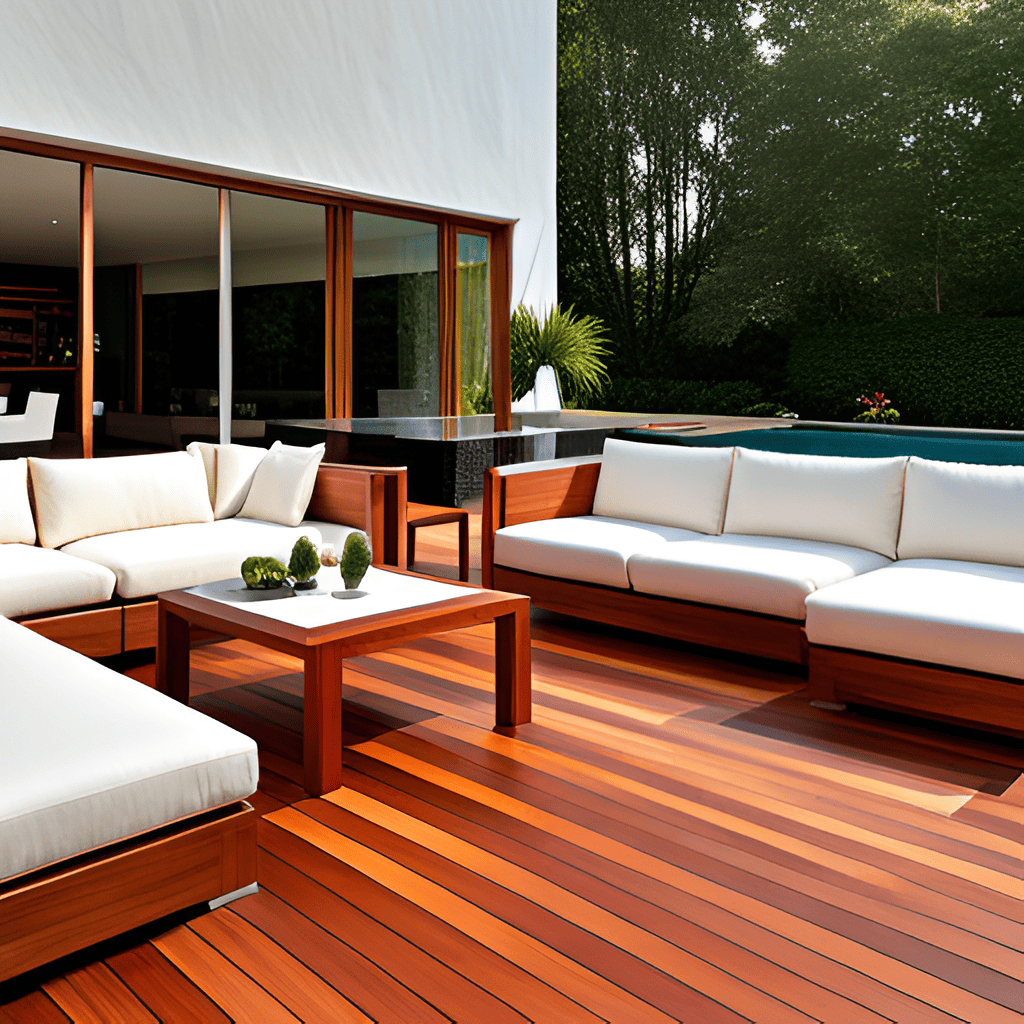Cumaru wood, also known as Brazilian Teak and tonka bean wood, is a dense and durable hardwood sourced from the Dipteryx spp. tree species native to South America. This versatile wood is prized for its strength and natural resistance to decay, making it ideal for various indoor and outdoor applications.
Cumaru is often used for outdoor projects like decking, furniture and fencing but is also commonly used for indoor flooring, furniture and stairs.
Below we’ll discuss all the great uses for Cumaru and we’ll also talk about key facts and figures related to the wood and the tree itself.
Check Out These Indoor And Outdoor Uses For Cumaru Wood
Some common uses of Cumaru wood include:
- Decking: Cumaru is a popular choice for decking due to its excellent durability and resistance to weathering, making it suitable for high-traffic outdoor areas.
- Outdoor Furniture: The dense and sturdy nature of Cumaru makes it well-suited for crafting durable outdoor furniture, such as benches, chairs, and tables.
- Flooring: Cumaru’s hardness and rich reddish-brown color make it a desirable option for hardwood flooring, adding warmth and elegance to interior spaces.
- Cladding and Siding: Cumaru wood is utilized for exterior cladding and siding, providing a beautiful and durable protective layer to buildings.
- Railings and Balustrades: The strength and stability of Cumaru wood make it suitable for creating sturdy railings and balustrades, adding safety and style to staircases and balconies.
- Fences and Gates: Cumaru’s resistance to decay and insects make it an excellent choice for building durable fences and gates that withstand the elements.
- Pergolas and Gazebos: Cumaru wood is used in the construction of pergolas and gazebos, offering a long-lasting and attractive shade solution for outdoor spaces.
- Bridge Construction: Cumaru’s strength and load-bearing capabilities make it suitable for building bridges and boardwalks in high-traffic areas.
- Boat Building: Due to its natural resistance to water and marine borers, Cumaru is used in boat construction, particularly for boat decks and components exposed to the elements.
- Indoor Applications: Cumaru wood’s attractive appearance and durability make it suitable for various indoor applications, such as stair treads, handrails, and cabinetry.
Cumaru’s versatility, beauty, and resistance to wear and tear make it a preferred choice for a wide range of applications in both residential and commercial settings. Its popularity has led to its use in various construction and woodworking projects worldwide.
Important Facts About Cumaru Trees And Wood
Here is a table with essential information about Cumaru wood from its native regions in South and Central America:
| Factors about Cumaru Wood | Description |
|---|---|
| Tree Species | Dipteryx spp. |
| Common Names | Cumaru, Brazilian Teak |
| Tree Height | Up to 30 meters (98 feet) |
| Trunk Diameter | Approximately 0.6 to 1.2 meters (2 to 4 feet) |
| Growth Environment | Native to South and Central America, tropical regions |
| Wood Grain | Interlocked, irregular grain pattern |
| Color | Rich reddish-brown with dark streaks |
| Density | High-density hardwood |
| Durability | Highly durable, resistant to rot, decay, and insects |
| Workability | Can be challenging to work due to hardness |

Viable Substitutes For Cumaru Wood
While Cumaru wood is highly valued for its unique properties, there are several alternative wood species that can serve as substitutes, offering similar characteristics and appearances.
Some suitable substitutes for Cumaru wood include:
- Ipe (Tabebuia spp.): Also known as Brazilian Walnut, Ipe shares many qualities with Cumaru, such as exceptional durability, strength, and a rich reddish-brown color. It is often used for decking, outdoor furniture, and siding.
- Merbau (Intsia bijuga): Merbau, or Kwila, is another dense and durable hardwood with a reddish-brown hue, making it a viable substitute for Cumaru in outdoor applications like decking and cladding.
- Bangkirai (Shorea laevis): Bangkirai offers a similar reddish-brown color and durability to Cumaru, making it suitable for decking, outdoor furniture, and other outdoor structures.
- Teak (Tectona grandis): Teak wood shares Cumaru’s high resistance to decay, insects, and moisture, making it an ideal substitute for outdoor furniture, decking, and boat building.
- Sapele (Entandrophragma cylindricum): Sapele exhibits a rich reddish-brown color and interlocked grain, making it a viable alternative for indoor applications like flooring, cabinetry, and fine furniture.
- Batu (Shorea spp.): Batu, also known as Red Balau, showcases reddish-brown hues and excellent durability, making it suitable for decking, outdoor furniture, and siding.
- Garapa (Apuleia leiocarpa): Garapa features a light to golden-brown color and good dimensional stability, making it an option for decking, cladding, and outdoor structures.
- Cumbiaba (Macrolobium spp.): Cumbiaba wood offers a rich reddish-brown color and strength, making it a potential substitute for Cumaru in various outdoor applications.
When considering a substitute for Cumaru wood, it’s crucial to evaluate the specific requirements of your project and the intended application. Each alternative wood has its unique characteristics, so consulting with wood experts or suppliers can help you choose the best substitute that meets your needs and preferences.
Final Thoughts
Cumaru wood, sourced from various species within the Dipteryx genus, is highly prized for its exceptional durability, hardness, and natural resistance to rot, decay, and insect attacks. The wood showcases a rich reddish-brown color with dark streaks, creating an attractive appearance for various applications.
However, due to its high density and interlocked grain, it can be somewhat challenging to work with. Its strength and resistance make it an excellent choice for outdoor projects like decking, siding, and furniture, as well as indoor applications like flooring and cabinetry.
Cumaru is a popular choice for construction and woodworking projects in its native regions and beyond, thanks to its impressive properties and natural beauty.

